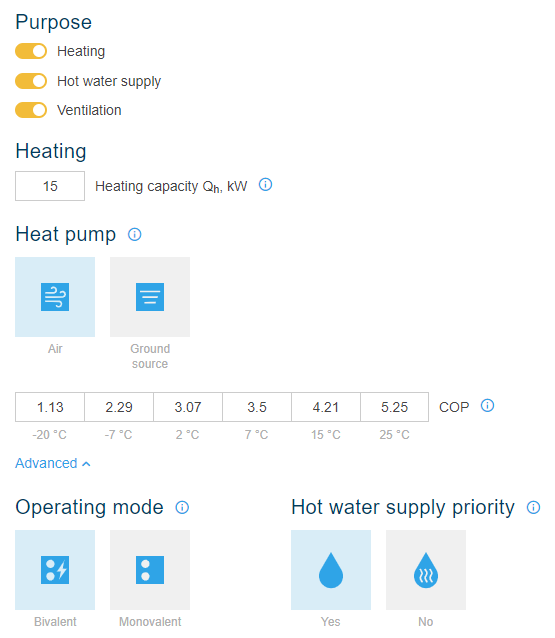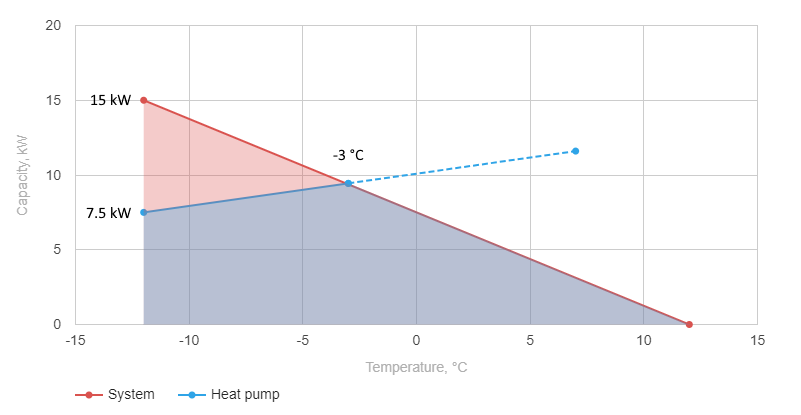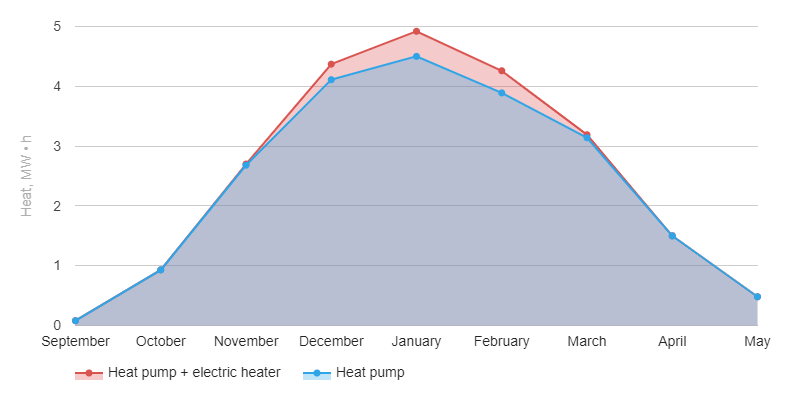Andrii Shirshov, CEO, geliştirici, SoftHVAC
Giriş
Muhtemelen ısı pompası gibi harika bir teknoloji hakkında bilgi sahibisinizdir. Isı pompası, tükettiği elektriğin 2-4,5 katı daha fazla ısı üretir ve kullanım maliyeti yanıcı yakıt kazanlarından daha ucuzdur. Ancak, ısı pompasının satın alma ve kurulum maliyeti kazanlardan daha yüksektir, bu nedenle ısı pompasının geri dönüş süresini belirlemek için kullanım maliyetini bilmek önemlidir.
Bu makalede, SoftHVAC firmasının harika bir çevrimiçi uygulamasını tanıtacağım. Bu uygulama ile bir ısı pompasının yıllık elektrik tüketim maliyetini belirleyebilir ve bunu elektrik, gaz, katı yakıt veya sıvı yakıt kazanlarının kullanımıyla karşılaştırabilirsiniz. Ayrıca, uygulama ısı pompasının tükettiği elektriğin CO2e sera gazı emisyonlarını hesaplar ve bunları gaz, katı yakıt veya sıvı yakıtın yanmasından kaynaklanan emisyonlarla karşılaştırır. Uygulama, herhangi bir model veya üreticiye ait bir ısı pompası için hesaplama yapmanıza olanak tanır.
Uygulama ücretsizdir ve şu linkten erişilebilir: https://www.softhvac.com/en/heat-pump
Tarifeler
Tüketilen enerji taşıyıcısının maliyetini hesaplamak için kullanıcı, bu enerji taşıyıcılarının bulunduğu bölgedeki fiyatlarını girer. Elektrik için tek veya çift (gündüz ve gece) tarifesini seçebilir ve çift tarifeyi kullanarak tasarrufu gözlemleyebilirsiniz, çünkü gece elektriği daha ucuzdur.
İklim Verileri
En doğru hesaplamayı yapmak için uygulama, belirli bir şehir için son 10-15 yılın günlük dış hava sıcaklıklarını kullanır. Kullanıcı, hesaplama için sıcaklık verilerinin kullanılacağı şehri seçer. İstenilen şehir listede yoksa, 200 km yarıçap içindeki en yakın şehir seçilebilir, çünkü bu şehirlerin verileri genellikle birbirinden çok farklı değildir. En yakın şehri ararken haritayı kullanabilirsiniz: https://www.softhvac.com/city-map
Isıtma Amacı
Bu bölümde (bkz. Şekil 1) bir veya daha fazla ısıtma amacını seçebilirsiniz:
- Isıtma.
- Sıcak su temini.
- Havalandırma.
Bu ısıtma kapasiteleri ve ısıtıcıların günlük çalışma süreleri girilmelidir.

Şekil 1. Kullanıcı ara yüzü
Sıcak su temini için, ısıtma ile ilgili önceliğini seçebilirsiniz. Eğer öncelik açıksa (genellikle açıktır), sıcak su tüketimi sırasında ısıtma sistemi durur, bu da ısı pompası kapasitesini ve maliyetini azaltır. Öncelik kapalıysa, hem ısıtma hem de sıcak su temini aynı anda gerçekleştirilir.
Isı Pompası
Isı pompası türünü seçebilirsiniz: hava kaynaklı veya jeotermal. Hava kaynaklı ısı pompasının ısı kaynağı dış hava iken, jeotermal ısı pompasının ısı kaynağı toprak veya yeraltı suyu olur. Ayrıca, elektrik gücünün ısıya dönüşüm katsayısı – COP (Verim Katsayısı) bu bölümde girilir, ilgili dış hava ve ısı taşıyıcı sıcaklığında. Bu veriler ısı pompasının teknik dokümantasyonunda bulunabilir.
Çalışma Modu
Isı pompası çalıştırmanın iki modu mevcuttur: bivalent veya monovalent.
- Monovalent mod: Isı pompasının kapasitesi sistemin maksimum kapasitesine eşit veya daha yüksek olur. Örneğin, ısıtma sistemi kapasitesi 15 kW ise ısı pompası da 15 kW olarak seçilmelidir.
- Bivalent mod: Isı pompasının kapasitesi sistemin maksimum kapasitesinden daha düşüktür ve eksik kapasite ayrı bir elektrikli ısıtıcı ile telafi edilir. Elektrikli ısıtıcının açıldığı sıcaklığa bivalent sıcaklık denir.
Elektrikli ısıtıcıya neden ihtiyaç duyulur? Çünkü daha az verimlidir, ancak iklimle ilgilidir. Prag şehri için örnek verelim:
- Isıtma döneminin minimum sıcaklığı -12 °C.
- Isıtma döneminin maksimum sıcaklığı +12 °C.
- Isıtma dönemi gün sayısı 215 gün.
- Isıtma sistemi kapasitesi 15 kW.
İklim verilerine bakıldığında, ısıtma dönemi süresinin yalnızca %9.3’ünde (215 günün 20 günü) sıcaklığın -12 ile -3 °C arasında olduğu görülür. Bu nedenle, ısı pompası kapasitesini sadece -3 °C sıcaklığına kadar yeterli olacak şekilde seçebiliriz (bivalent sıcaklık) ve daha düşük ve nadir sıcaklıklarda elektrikli ısıtıcı ısı pompasına ek olarak açılır (bkz. Şekil 2). Bu durumda ısı pompasının -12 °C’deki kapasitesi 7.5 kW ve elektrikli ısıtıcı kapasitesi de 7.5 kW olacaktır. Elektrikli ısıtıcının ürettiği ısı miktarı yılda sadece %4.67 olacaktır.

Şekil 2. Bivalent sıcaklık.
Bu şekilde, ısı pompası kapasitesini %50 oranında (15 kW’dan 7.5 kW’a) azaltmayı başardık ve dolayısıyla maliyetini düşürdük, elektrik tüketiminde küçük bir artışla birlikte. “Bivalent sıcaklık” diyagramındaki mavi renk ısı pompasının çalışma alanını, kırmızı renk ise elektrikli ısıtıcının çalışma alanını gösterir. “Seviye” kaydırıcısı ile ısı pompası ve elektrikli ısıtıcı kapasitesinin oranını değiştirerek bivalent sıcaklığı değiştirebilirsiniz. Elektrikli ısıtıcının ürettiği ısı miktarını yılda %5 veya daha az olacak şekilde ayarlamanız önerilir.
Sonuç
Bu kadar kolay ve zahmetsiz bir şekilde hesaplama tamamlanmıştır. “Sonuç” bölümünde ana veriler sunulmuştur:
- Isı pompası, elektrikli, gaz, katı ve sıvı yakıt kazanlarının yıllık kullanım maliyeti.
- Isı pompası kapasitesi.
- Elektrikli ısıtıcı kapasitesi.
- Elektrikli ısıtıcının termal performansı.
- Bivalent sıcaklık.
- Sağlanan faydalı ısı.
- Elektrik enerjisi tüketimi.
Daha ayrıntılı bir hesaplama sonucu Excel dosyası olarak indirilebilir. Ayrıca birçok diyagram oluşturulmuştur:
- Enerji taşıyıcısı maliyeti (bkz. Şekil 3).
- Termal performans (bkz. Şekil 4).
- Sağlanan ısı.
- Ortalama COP.
- Elektrik enerjisi tüketimi.
- CO2e emisyonları (bkz. Şekil 5).

Şekil 3. Enerji taşıyıcısı maliyeti.

Şekil 4. Termal performans.

Şekil 5. CO2e emisyonları.
Isı pompası ve elektrikli kazan için CO2e emisyonlarının hesaplanması, seçilen ülkedeki üretilen ve ithal edilen elektrikten kaynaklanan CO2e emisyonlarına dayanır. Bu veriler farklı ülkelerde sürekli değişmektedir, bu nedenle uygulamada da düzenli olarak güncellenir.
Hesaplamanın Kaydedilmesi ve Açılması
Hesaplama indirilebilir ve daha sonra görüntülemek veya düzenlemek üzere proje dosyasından yüklenebilir.
Sonuç
Isı pompası seçimi için temel yaklaşımları ve yöntemleri gözden geçirdik. Ayrıca, kullanabileceğiniz harika çok amaçlı bir uygulama hakkında bilgi sahibi olduk:
- En uygun ısı pompasını seçmek.
- Isı pompasının geri dönüş süresini belirlemek.
- Potansiyel bir müşteriye görsel bir hesaplama sunarak onu satın almaya ikna etmek.
- Farklı üreticilerin ısı pompalarının maliyet etkinliğini karşılaştırmak.
- Isı pompasının en ekonomik olarak uygulanabilir olduğu şehirleri belirlemek.
- Isı pompasının yanıcı yakıt kazanlarına göre ne kadar daha az sera gazı emisyonu yaptığını görmek.
—————————————————————————————————————–
Calculation of The Cost Of a Heat Pump Usage
Selection of the optimal heat pump requires you to know the cost of electricity consumed by a heat pump, and how much more energy-saving the heat pump is compared to the fuel boiler. We are going to look at the online tool, whereby we can determine the annual cost of the heat pump use, CO2e greenhouse gas emissions and compare that data to fuel boilers.
Introduction
You probably know such a great technology as a heat pump, it produces 2-4.5 times more heat than its consumption of electricity, and the cost of its usage is cheaper than that of combustible fuel boilers. But at the same time, the capital cost of purchasing and installing a heat pump is higher than that of boilers, which means that in order to determine the payback of a heat pump it is important to know the cost of its usage.
In this article I will present you a great online application from SoftHVAC company, with its help you can determine the cost of electrical power consumed by a heat pump during a year and compare it with the cost of using an electric, gas, solid fuel or liquid fuel boiler.
In addition, the application also determines the CO2e greenhouse gas emissions from electrical power consumed by a heat pump and compares them with the emissions from combustion of gas, solid or liquid fuel.
The application is made multipurpose allowing you to perform calculations for a heat pump of any model of any manufacturer.
The application is free of charge and can be accessed by the link: https://www.softhvac.com/en/heat-pump
Tariffs
To calculate the cost of the consumed energy carrier, the user enters the prices for these energy carriers in the given region.
For electrical power you can select a single or double (day and night) tariff for electrical power and observe the savings due to the usage of the double tariff, as electrical power is cheaper at night.
Climatology
In order to perform the most accurate calculation, the application uses the database of outside air temperatures of each day for the last 10-15 years for a particular city.
The user selects the city, the temperature data of which will be used for the calculation.
If the desired city is not in the list, the nearest city within the radius of 200 km can be selected, as the data of these cities usually do not differ much from each other.
For convenience, when searching the nearest city, you can use the map:
Today the application contains 187 cities, in addition, you can send a request to the developer to add a new city.
Heating purpose
In this section (see Figure 1) you can select one or more heating purposes:
- Heating.
- Hot water supply.
- Ventilation.
The capacities of these heatings and the operating time of the heaters within twenty-four hours should be entered.

Figure 1. User interface.
For the hot water supply you can select the priority of its operation in relation to the heating.
If the priority is on (as a rule it is on), during water consumption of the hot water supply, heating of the heating system is stopped, this allows to reduce the heat pump capacity and its cost.
If the priority is off, both heating of the heating system and hot water supply is performed simultaneously.
Heat pump
You can select the type of heat pump: air-source or geothermal.
The heat source of an air-source heat pump is the outside air, while for a geothermal heat pump it is the ground or groundwater.
Also, the coefficient of conversion of electrical power into thermal – COP is entered in this section, at the respective temperature of outside air and heat carrier. This data can be found in the technical documentation of the heat pump.
Operating mode
Two modes of a heat pump operation are available: bivalent or monovalent.
Monovalent mode – the heat pump has a capacity equal to or higher than the maximum capacity of the system. For example, if the heating system capacity is 15 kW, the heat pump should be selected for 15 kW as well.
Bivalent mode – the heat pump has a capacity lower than the maximum capacity of the system and the lacking capacity is compensated by a separate electric heater.
The temperature at which the electric heater is turned on is called the bivalent temperature.
You may ask why do you need an electric heater, since it is less efficient than a heat pump? It’s all about climate.
Let’s consider the case for the city of Prague:
- Minimum temperature of the heating period is -12 °C.
- Maximum temperature of the heating period is +12 °C.
- Number of days of the heating period is 215 days.
- Heating system capacity is 15 kW.
Looking at climatological data, it is found that only 9.3 % of the heating period duration (20 days out of 215) the temperature was between -12 and -3 °C.
So, we can select such a heat pump capacity that it would be sufficient only, for example, up to the temperature of -3 °C (bivalent temperature), and at lower and rare temperatures an electric heater would be switched on in addition to the heat pump (see Figure 2).
Then the capacity of the heat pump at -12 °C will be 7.5 kW and the capacity of the electric heater will also be 7.5 kW. The amount of heat produced by the electric heater will be only 4.67 %/year.

Figure 2. Bivalent temperature
Thus, we managed to reduce the heat pump capacity by 50% (from 15 kW to 7.5 kW) and consequently its cost, with a minor increase of electrical power consumption.
The blue color on the “Bivalent temperature” diagram shows the area of operation of the heat pump and the red color shows the area of operation of the electric heater.
By means of the “Level” slider you can change the ratio of the heat pump and electric heater capacity, which will also change the bivalent temperature. It is recommended to adjust the bivalent temperature so as the heat produced by the electric heater is qte ≤ 5 %/year.
Result
That’s it, so easily and effortlessly the calculation has been done.
The “Result” section presents the main data:
- Cost of usage for a heat pump, electric, gas, solid and liquid fuel boiler per year.
- Heat pump capacity.
- Electric heater capacity.
- Thermal performance of an electric heater.
- Bivalent temperature.
- Useful heat provided.
- Electrical energy consumption.
A more complete calculation result can be obtained by downloading the report as an Excel file.
In addition, many diagrams have been created:
- Energy carrier cost (see Figure 3).
- Thermal performance (see Figure 4).
- Heat provided.
- Average COP.
- Electrical energy consumption.
- CO2e emissions (see Figure 5).

Figure 3. Energy carrier cost

Figure 4. Thermal performance.

Figure 5. CO2e emissions.
The calculation of CO2e emissions for the heat pump and electric boiler is performed based on CO2e emissions from the produced and imported electrical power in the selected country. These data are constantly changing in different countries, so they are also regularly updated in the application.
Saving and opening the calculation
The calculation can be downloaded and then uploaded from the project file so that it can be reopened for viewing or editing in the future.
Conclusion
We have overviewed the main approaches and methods for selecting a heat pump.
Have learnt about a great multipurpose application that you can use to:
- Select the most appropriate heat pump.
- Determine the payback period of a heat pump.
- Provide a potential customer with a visual calculation to convince them to purchase.
- Compare the cost-effectiveness of the heat pumps from different manufacturers.
- Identify cities where a heat pump is most economically feasible.
- See how much the greenhouse gas emissions are less from a heat pump compared to combustible fuel boilers.
![]()